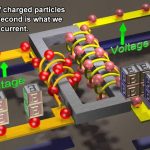This article explains the essential concepts and assumptions of the Longley-Rice propagation model, which is otherwise known as the Irregular Terrain Model (ITM).
The Longley-Rice propagation model is a general purpose model that is applicable to a wide range of engineering problems. Let us go through a brief introduction to the topic before going into the detailed analysis.
Longley-Rice is a system for forecasting the attenuation of radio waves in the frequency range of 20 MHz to 20 GHz (or path lengths ranging from 1 km to 2000 km) for a telecommunication link. In other words, this radio propagation model forecasts long-lasting median transmission loss across asymmetrical terrain relative to white-space transmission loss.
Application of Longley-Rice Model in Industries
The Longley-Rice model is a widely accepted model in the industry; the Federal Communications Commission (FCC) has also adopted this model as standard. It was initially developed for the frequency planning needs of TV broadcasting in the US.
This model includes two parts – one model for predictions across an area and the other for point-to-point link forecasting. In the following section, we will look at the required parameters for the ITM model.
Longley-Rice Propagation Model Parameters
Some of the important parameters required for this propagation model are:
· Frequency: The nominal frequency range is 20 MHz to 20 GHz.
· Effective Radiated Power: ERP is entered as per the units set by the user (W, mW, kW, dBW, dBm, dBk)
· Antenna: Omni-directional transmitter operation is an assumption, if the directional antenna is not mentioned.
· Height: The height of antenna above the ground has to be entered as per units set by user (meters or feet); the effective height for calculations will be estimated by the program itself.
· Polarization: Vertical or horizontal polarization must be entered.
· Surface Refractivity: This is the refractivity of the atmosphere, measured in N-Units (parts per million), which typically ranges from 250 to 400 N-units
The effective earth curvature of 4/3 corresponds to a surface refractivity of 301 N-units, and Longley-Rice recommends an Ns that comes out to be 301 N-units for average atmospheric conditions.
You can use different values of the effective earth curvature value K, in order to compute the surface refractivity Ns from the following formula:
![]() Permittivity: This is the dielectric constant of the ground.
Permittivity: This is the dielectric constant of the ground.

· Conductivity: Soil conductivity of the ground.
· Climate Zone: This has to be entered as per the climate codes.
· Situation Variability: It is expressed as a percentage; 50% variability is considered normal for coverage estimations.
· Time Variability: This is also expressed as percentage (0 to 100)
Terrain Profile Features
The Longley-Rice model makes use of elevation values for creating a brief profile of a path for program analysis. These values are read from the Terrain Analysis Package (TAP) database for elevation.
The original model expects terrain profile details at the same increments throughout a particular path. The specified parameters for elevation data extraction have to be first read to evaluate compliance with the equal spacing requirements .i.e. the spacing between the points on a specific radial must be the same.
This spacing is presumed to be the space from the site to the elevation point that comes first on the radial. Any successive points that are at a distance less than that of the previous one are ignored.
If this spacing is greater than the evaluated equal spacing, then the residual data cannot be processed and the particular portion is left out. The program will calculate values of field strength to the final equally spaced point on the radial.
Path Parameter Calculations
Now, let’s look at the path parameter calculations:
· Effective antenna height: This can be described as the antenna’s height on top of the effective reflecting plane. The range of interest is first determined depending on the “over the ground elevation” and the horizon spacing between each antenna; then it makes use of one of the ways to evaluate the effective height.
· Elevation angles and horizon distances: This is the angle by which the horizon rays are depressed relative to the horizontal at every antenna. This angle is calculated by making use of terrain profile details.
· Terrain irregularity: It first makes use of a linear interpolation to hold a straight line in the range of interest and then decides a range h(d) over and under this line, and terrain irregularity is then evaluated.
· Reference attenuation: For estimating transmission loss relative to the white space, this model makes use of the generated horizon distances and elevations.
Conclusion
One of the significant advantages of the Longley-Rice propagation model is its capability to set different parameters that have an effect on the way in which computations are done; thus the model can be customized for a wide range of applications.
All the above discussion is only a quick overview of the parameters used in Longley-Rice propagation model; we’ll keep you updated on latest developments, and advancements over this model as FCC makes the “white spaces” from unallocated TV channels available for ultra-WiFi


